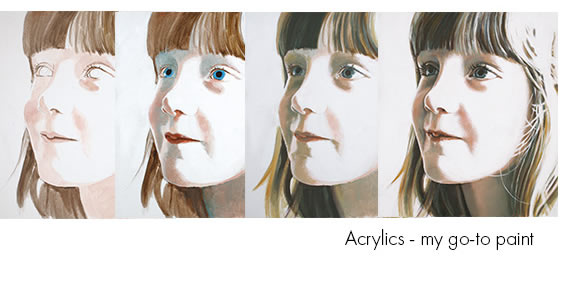MARCH 2023 - WHY IS ACRYLIC PAINT MY GO-TO PAINT?
April 12, 2023
Of course, each type of paint has its own unique benefits and drawbacks, and the choice ultimately comes down to personal preference and the specific needs of the project. I have tried oils, watercolours and acrylics and find acrylics the most versatile for my style of artwork. In my opinion there are numerous benefits...

ACRYLICS V OILS
Drying time - Acrylic paint dries much faster than oil paint, which can take days or even weeks to dry completely. This allows for a faster workflow and the ability to layer paint more quickly.
Cleanup: Acrylic paint is water-soluble, which means it can be easily cleaned up with water and soap. Oil paint, on the other hand, requires solvents like turpentine or mineral spirits for cleanup, which can be harmful to both the environment and the artist's health.
Versatility: Acrylic paint can be used on a variety of surfaces, including paper, canvas, wood, and more. It can also be used in a variety of techniques, such as pouring, glazing, and even airbrushing. Oil paint, while versatile, requires specialized surfaces and tools.
Color fastness: Acrylic paint is known for its vibrant and long-lasting colors. It resists fading over time, even when exposed to sunlight and other environmental factors. Oil paint can also have long-lasting colors, but certain pigments may fade or change over time.
ACRYLICS v WATERCOLOURS
Opacity: Acrylic paints are more opaque than watercolors, meaning that they can provide greater coverage and allow for more depth and texture in a painting. This makes them a better choice for creating bold, vibrant colors and for painting on darker surfaces.
Flexibility: Acrylic paints are more flexible than watercolors, meaning that they can be applied in thicker layers and can be used to create a variety of textures and effects. Watercolors, on the other hand, are more limited in their application and tend to be used in a more traditional, transparent style.
Durability: Acrylic paints are more durable than watercolors, as they are water-resistant and do not require framing or protection behind glass. This makes them a better choice for painting on surfaces that may be exposed to moisture or light.
Versatility: Acrylic paints can be used on a variety of surfaces, including canvas, paper, wood, and even fabric. They can also be used for a variety of techniques, such as pouring, glazing, and even airbrushing. Watercolors, on the other hand, are typically used on paper and are best suited for painting in a transparent, delicate style.